The iPhone 5s Review
by Anand Lal Shimpi on September 17, 2013 9:01 PM EST- Posted in
- Smartphones
- Apple
- Mobile
- iPhone
- iPhone 5S
Display
The iPhone 5s, like the iPhone 5c, retains the same 4-inch Retina Display that was first introduced with the iPhone 5. The 4-inch 16:9 LCD display features a 1136 x 640 resolution, putting it at the low end for most flagship smartphones these days. It was clear from the get-go that a larger display wouldn’t be in the cards for the iPhone 5s. Apple has stuck to its two generation design cadence since the iPhone 3G/3GS days and it had no indication of breaking that trend now, especially with concerns of the mobile upgrade cycle slowing. Recouping investment costs on platform and industrial design are a very important part of making the business work.

Apple is quick to point out that iOS 7 does attempt to make better use of display real estate, but I can’t shake the feeling of being too cramped on the 5s. I’m not advocating that Apple go the route of some of the insanely large displays, but after using the Moto X for the past month I believe there’s a good optimization point somewhere around 4.6 - 4.7”. I firmly believe that Apple will embrace a larger display and branch the iPhone once more, but that time is just not now.
The 5s’ display remains excellent and well calibrated from the factory. In an unusual turn of events, my iPhone 5c sample came with an even better calibrated display than my 5s sample. It's a tradeoff - the 5c panel I had could go way brighter than the 5s panel, but its black levels were also higher. The contrast ratio ended up being very similar between the devices as a result. I've covered the panel lottery in relation to the MacBook Air, but it's good to remember that the same sort of multi-source components exist in mobile as well.
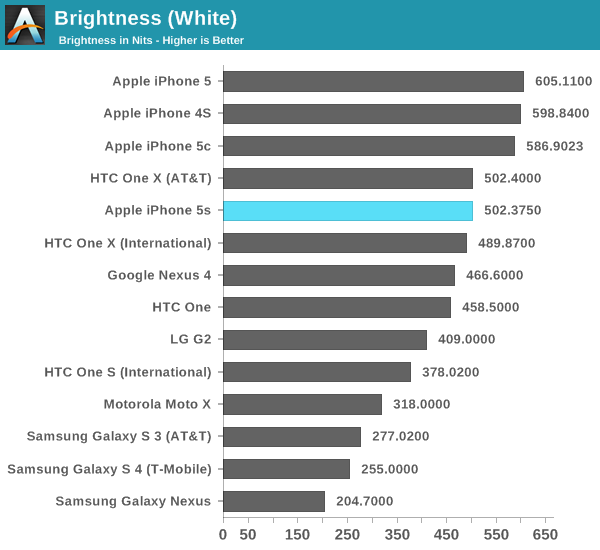
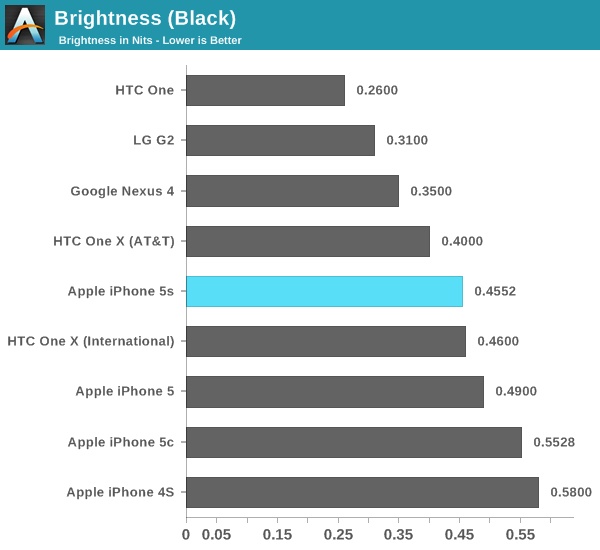
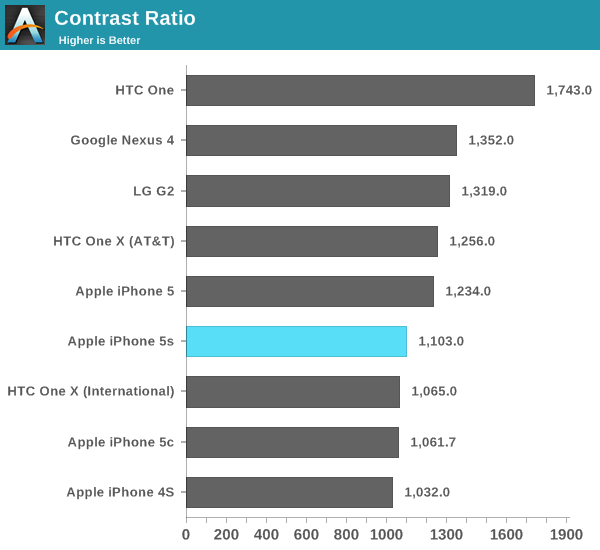
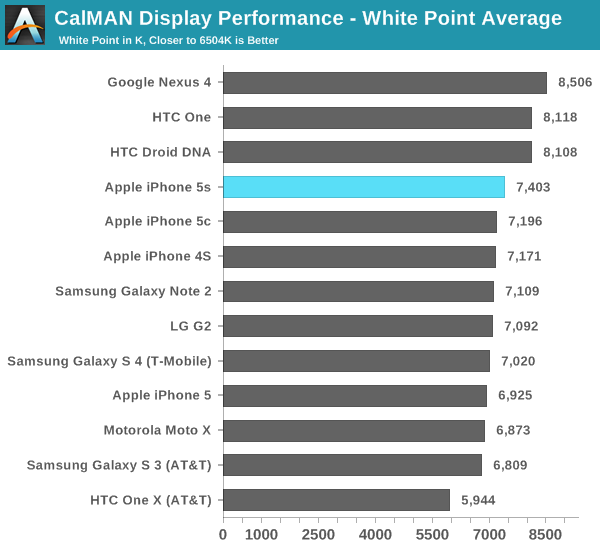

Color accuracy is still excellent just out of the box. Only my iPhone 5c sample did better than the 5s in our color accuracy tests. Grayscale accuracy wasn't as good on my 5s sample however.
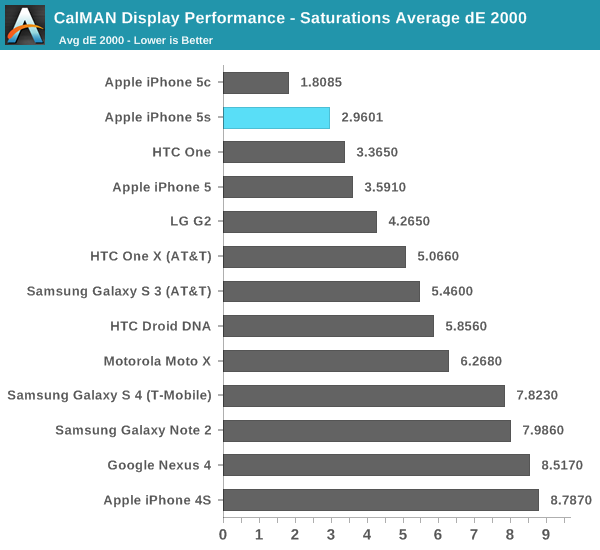
Saturations:

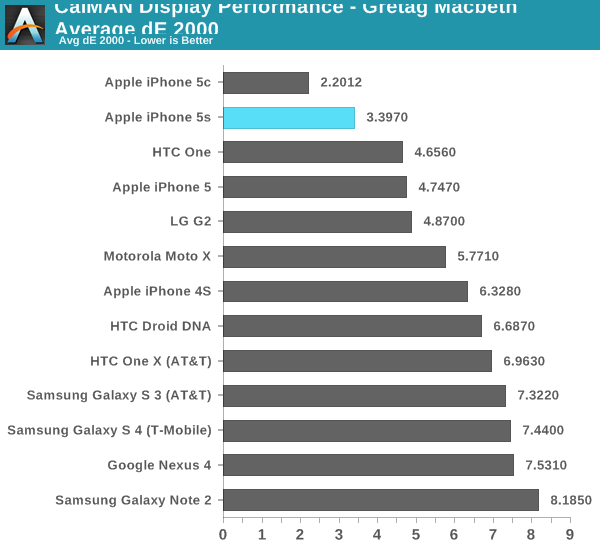
GMB Color Checker:

Cellular
When early PCB shots of the 5s leaked, I remember Brian counting solder pads on the board to figure out if Apple moved to a new Qualcomm baseband solution. Unfortunately his count came out as being the same as the existing MDM9x15 based designs, which ended up what launched. It’s unclear whether or not MDM9x25 was ready in time in order to be integrated into the iPhone 5s design, or if there was some other reason that Apple chose against implementing it here. Regardless of the why, the result is effectively the same cellular capabilities as the iPhone 5.
Apple tells us that the wireless stack in the 5c and 5s is all new, but the lack of LTE-Advanced features like carrier aggregation and Category 4 150Mbps downlink make it likely that we’re looking at a MDM9x15 derivative at best. LTE-A support isn’t an issue at launch, however as Brian mentioned on our mobile show it’s going to quickly become a much needed feature for making efficient use of spectrum and delivering data in the most power efficient way.
The first part is relatively easy to understand. Carrier aggregation gives mobile network operators the ability of combining spectrum across non-contiguous frequency bands to service an area. The resulting increase in spectrum can be used to improve performance and/or support more customers on LTE in areas with limited present day LTE spectrum.
The second part, improving power efficiency, has to do with the same principles of race to sleep that we’ve talked about for years. The faster your network connection, the quicker your modem can transact data and fall back into a lower power sleep state.
The 5s’ omission of LTE-A likely doesn’t have immediate implications, but those who hold onto their devices for a long time will have to deal with the fact that they’re buying at the tail end of a transition to a new group of technologies.
In practice I didn’t notice substantial speed differences between the iPhone 5s, 5c and the original iPhone 5. My testing period was a bit too brief to adequately characterize the device but I didn’t have any complaints. The 5s retains the same antenna configuration as the iPhone 5, complete with receive diversity. As Brian discovered after the launch, the Verizon iPhone 5s doesn’t introduce another transmit chain - so simultaneous voice and LTE still aren’t possible on that device.
Apple is proud of its support for up to 13 LTE bands on some SKUs. Despite the increase in support for LTE bands there are a lot of iPhone 5s SKUs that will be shipped worldwide:
| Apple iPhone 5S and 5C Banding | |||||||
| iPhone Model | GSM / EDGE Bands | WCDMA Bands | FDD-LTE Bands | TDD-LTE Bands | CDMA 1x / EVDO Rev A/B Bands | ||
|
5S- A1533 (GSM) |
850, 900, 1800, 1900 MHz | 850, 900, 1700/2100, 1900, 2100 MHz | 1, 2, 3, 4, 5, 8, 13, 17, 19, 20, 25 | N/A | N/A | ||
|
5S- A1533 (CDMA) |
800, 1700/2100, 1900, 2100 MHz | ||||||
|
5S- A1453 |
1, 2, 3, 4, 5, 8, 13, 17, 18, 19, 20, 25, 26 | ||||||
|
5S- A1457 5C- A1507 |
850, 900, 1900, 2100 MHz | 1, 2, 3, 5, 7, 8, 20 | N/A | ||||
|
5S- A1530 5C- A1529 |
1, 2, 3, 5, 7, 8, 20 | 38, 39, 40 | |||||
| Apple iPhone 5S/5C FCC IDs and Models | |||
| FCC ID | Model | ||
| BCG-E2642A | A1453 (5S) A1533 (5S) | ||
| BCG-E2644A | A1456 (5C) A1532 (5C) | ||
| BCG-E2643A | A1530 (5S) | ||
| BCG-E2643B | A1457 (5S) | ||
| BCG-E2694A | A1529 (5C) | ||
| BCG-E2694B | A1507 (5C) | ||
WiFi
WiFi connectivity also remains unchanged on the iPhone 5s. Dual band (2.4/5GHz) 802.11n (up to 150Mbps) is the best you’ll get out of the 5s. We expected Apple to move to 802.11ac like some of the other flagship devices we’ve seen in the Android camp, but it looks like you’ll have to wait another year for that.
I don’t believe you’re missing out on a lack of 802.11ac support today, but over the life of the iPhone 5s I do expect greater deployment of 802.11ac networks (which can bring either performance or power benefits to a mobile platform).
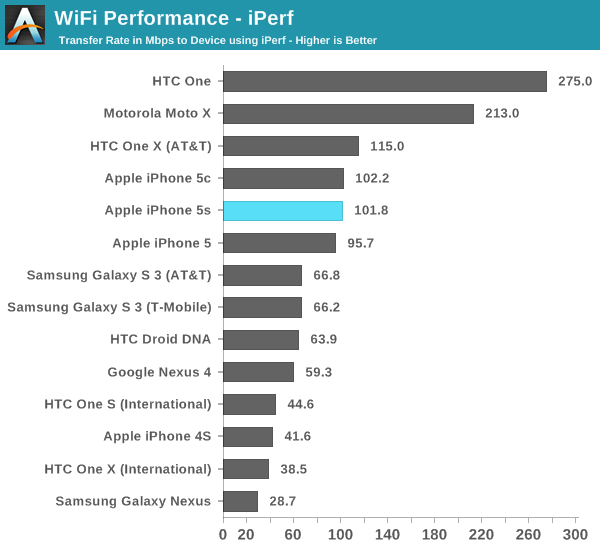
WiFi performance seems pretty comparable to the iPhone 5. The HTC One and Moto X pull ahead here as they both have 802.11ac support.













464 Comments
View All Comments
ddriver - Wednesday, September 18, 2013 - link
I mean, only a true apple fanboy is capable of disregarding all that technical argumentation because of the mention of the term "apple fanboys". A drowning man will hold onto a straw :)akdj - Thursday, September 19, 2013 - link
You consider your comment 'technical argumentation'? It's not....it's your 'opinion'. I think you can rest assured Anand's site is geared much more to those of us interested in technology and less interested in being a 'fanboy'. In fact....so far reading through the comments, you're the first to bring that silly cliché up, "Fan Boy".A drowning man will hold on to anything to help save himself :)
Wilco1 - Wednesday, September 18, 2013 - link
Good comment - I'm equally unimpressed by the comparison of a real phone with a Bay Trail tablet development board which has significantly higher TDP. And then calling it a win for Bay Trail based on a few rubbish JS benchmarks is even more ridiculous. These are not real CPU benchmarks but all about software optimization and tuning for the benchmark.Single threaded Geekbench 3 results show the A7 outperforming the 2.4GHz Bay Trail by 45%. That's despite the A7 running at only 54% of the frequency of Bay Trail! In short, A7 is 2.7 times faster than BT and on par/better than HasWell IPC...
tech4real - Wednesday, September 18, 2013 - link
not trying to dismiss A7's cpu core, it's an amazing silicon and significantly steps up against A6, but is there a possibility that the geekbench3 is unfit to gauge average cross-ISA cross-OS cpu performance... To me, the likelihood of this is pretty high.Wilco1 - Wednesday, September 18, 2013 - link
Comparing different ISAs does indeed introduce inaccuracies due to compilers not being equal. Cross OS is less problematic as long as the benchmark doesn't use the OS a lot.It's a good idea to keep this in mind, but unfortunately there is little one can do about it. And other CPU benchmarks are not any better either, if you used SPEC then performance differences across different compilers are far larger than Geekbench (even on the same CPU the difference between 2 compilers can be 50%)...
Dooderoo - Wednesday, September 18, 2013 - link
"The AES and SHA1 gains are a direct result of the new cryptographic instructions that are a part of ARMv8. The AES test in particular shows nearly an order of magnitude performance improvement".Your comment: "in reality the encryption workloads are handled in a fundamentally different way in the two modes [...] a mixed bad into one falsely advertising performance gains attributed to 64bit execution and not to the hardware implementations as it should"
Maybe actually read the article?
"The FP chart also shows no miracles, wider SIMD units result in almost 2x the score in few tests, nothing much in the rest"
Exclude those test and you're still looking at 30% improvement. 30% increase in performance from a recompile counts at "nothing much" in what world?
ddriver - Wednesday, September 18, 2013 - link
My point was encryption results should not have been included in the chart and presented as "benefits of 64bit execution mode" because they aren't.Also those 30% can easily be attributed to other incremental upgrades to the chip, like faster memory subsystem, better prefetchers and whatnot. Not necessarily 64bit execution, I've been using HPC software for years and despite the fact x64 came with double the registers, I did not experience any significant increase in the workloads I use daily - 3D rendering, audio and video processing and multiphysics simulations. The sole benefit of 64bit I've seen professionally is due to the extra ram I can put into the machine, making tasks which require a lot of ram WAY FASTER, sometimes 10s even 100s times faster because of the avoided swapping.
Furthermore, I will no longer address technically unsubstantiated comments, in order to avoid spamming all over the comment space.
Dooderoo - Wednesday, September 18, 2013 - link
"Furthermore, I will no longer address technically unsubstantiated comments, in order to avoid spamming all over the comment space."Man, you give up too easily.
Encryption results are exactly that: "benefits of 64bit execution mode". Why? 32-bit A32 doesn't have the instructions, 64-bit A64 does. Clear and obvious benefit.
"30% can easily be attributed to other incremental upgrades to the chip". Wouldn't the 32-bit version benefit from those as well?
I'm beginning to think you don't understand that those results are both from the A7 SOC, once run with A32 and once with A64.
ddriver - Wednesday, September 18, 2013 - link
""30% can easily be attributed to other incremental upgrades to the chip". Wouldn't the 32-bit version benefit from those as well?"This may be correct. Unless I am overlooking execution mode details, of which I am not aware, and I expect neither are you, unless you are an engineer who has worked on the A7 chip. I don't think that data is available yet to comment on it in detail.
But you are not correct about encryption results, because it is a matter of extra hardware implementation. It is like comparing software rendering to hardware rendering, a CPU with hardware implementation of graphics will be immensely faster at a graphics workload, even if it is the same speed as the one that runs graphics in software. If anything, the architecture upgrades of the A7 chip can at best result in 2x peak theoretical performance improvement, while the AES test shows 8+x improvement. This is because the performance boost is not due to 64 bit mode execution, but due to the extra hardware implementation that is exclusively available in that mode.
Dooderoo - Wednesday, September 18, 2013 - link
"I don't think that data is available yet to comment on it in detail."Yet you're ok with calling the article "cunningly deceitful"? Weird.